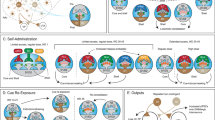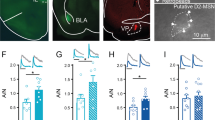Abstract
Drugs of abuse affect behavior by altering neuronal communication within the brain. Previous research examining the effects of intraperitoneally administered cocaine has revealed that cocaine alters excitatory glutamatergic signaling, both directly through regulation of synaptic function, and indirectly through regulation of cellular excitability in areas of the drug reward circuitry such as the nucleus accumbens (NAcc) and ventral tegmental area. We have now extended these findings by testing the hypothesis that self-administration of cocaine might elicit similar alterations in excitatory signaling in the NAcc shell. We observed that cocaine self-administration reduces synaptically evoked excitatory responses recorded extracellularly in the NAcc shell compared to saline self-administration. This alteration was not accompanied by alterations in paired pulse ratio of synaptically evoked responses or in potentiation of these responses by application of the adenylyl cyclase activator forskolin. This reduction in glutamatergic signaling may be one mechanism by which cocaine exerts its long-term behavioral effects.
Similar content being viewed by others
Log in or create a free account to read this content
Gain free access to this article, as well as selected content from this journal and more on nature.com
or
References
Baker DA, Xi ZX, Shen H, Swanson CJ, Kalivas PW (2002). The origin and neuronal function of in vivo nonsynaptic glutamate. J Neurosci 22: 9134–9141.
Beurrier C, Malenka RC (2002). Enhanced inhibition of synaptic transmission by dopamine in the nucleus accumbens during behavioral sensitization to cocaine. J Neurosci 22: 5817–5822.
Borgland SL, Malenka RC, Bonci A (2004). Acute and chronic cocaine-induced potentiation of synaptic strength in the ventral tegmental area: electrophysiological and behavioral correlates in individual rats. J Neurosci 24: 7482–7490.
Brundege JM, Williams JT (2002). Differential modulation of nucleus accumbens synapses. J Neurophysiol 88: 142–151.
Caine SB, Negus SS, Mello NK, Patel S, Bristow L, Kulagowski J et al (2002). Role of dopamine D2-like receptors in cocaine self-administration: studies with D2 receptor mutant mice and novel D2 receptor antagonists. J Neurosci 22: 2977–2988.
Carroll ME, France CP, Meisch RA (1979). Food deprivation increases oral and intravenous drug intake in rats. Science 205: 319–321.
Carroll ME, France CP, Meisch RA (1981). Intravenous self-administration of etonitazene, cocaine and phencyclidine in rats during food deprivation and satiation. J Pharmacol Exp Ther 217: 241–247.
Cordingley GE, Weight FF (1986). Non-cholinergic synaptic excitation in neostriatum: pharmacological evidence for mediation by a glutamate-like transmitter. Br J Pharmacol 88: 847–856.
Cornish JL, Duffy P, Kalivas PW (1999). A role for nucleus accumbens glutamate transmission in the relapse to cocaine-seeking behavior. Neuroscience 93: 1359–1367.
Cornish JL, Kalivas PW (2000). Glutamate transmission in the nucleus accumbens mediates relapse in cocaine addiction. J Neurosci (Online) 20: RC89.
Crespo JA, Manzanares J, Oliva JM, Corchero J, Garcia-Lecumberri C, Ambrosio E (2003). Extinction of cocaine self-administration produces alterations in corticotropin releasing factor gene expression in the paraventricular nucleus of the hypothalamus. Brain Res Mol Brain Res 117: 160–167.
Deroche V, Caine SB, Heyser CJ, Polis I, Koob GF, Gold LH (1997). Differences in the liability to self-administer intravenous cocaine between C57BL/6 × SJL and BALB/cByJ mice. Pharmacol Biochem Behav 57: 429–440.
Dumont EC, Mark GP, Mader S, Williams JT (2005). Self-administration enhances excitatory synaptic transmission in the bed nucleus of the stria terminalis. Nat Neurosci 8: 413–414.
Hu XT, Basu S, White FJ (2004). Repeated cocaine administration suppresses HVA-Ca2+ potentials and enhances activity of K+ channels in rat nucleus accumbens neurons. J Neurophysiol 92: 1597–1607.
Hu XT, Ford K, White FJ (2005). Repeated cocaine administration decreases calcineurin (PP2B) but enhances DARPP-32 modulation of sodium currents in rat nucleus accumbens neurons. Neuropsychopharmacology 30: 916–926.
Hyman SE, Malenka RC (2001). Addiction and the brain: the neurobiology of compulsion and its persistence. Nat Rev Neurosci 2: 695–703.
Kim JH, Austin JD, Tanabe L, Creekmore E, Vezina P (2005). Activation of group II mGlu receptors blocks the enhanced drug taking induced by previous exposure to amphetamine. Eur J Neurosci 21: 295–300.
Kim JH, Vezina P (1998a). The metabotropic glutamate receptor antagonist (RS)-MCPG produces hyperlocomotion in amphetamine pre-exposed rats. Neuropharmacology 37: 189–197.
Kim JH, Vezina P (1998b). Metabotropic glutamate receptors are necessary for sensitization by amphetamine. Neuroreport 9: 403–406.
Lovinger DM, Partridge JG, Tang KC (2003). Plastic control of striatal glutamatergic transmission by ensemble actions of several neurotransmitters and targets for drugs of abuse. Ann NY Acad Sci 1003: 226–240.
Lu L, Grimm JW, Shaham Y, Hope BT (2003). Molecular neuroadaptations in the accumbens and ventral tegmental area during the first 90 days of forced abstinence from cocaine self-administration in rats. J Neurochem 85: 1604–1613.
Lu W, Chen H, Xue CJ, Wolf ME (1997). Repeated amphetamine administration alters the expression of mRNA for AMPA receptor subunits in rat nucleus accumbens and prefrontal cortex. Synapse 26: 269–280.
Lu W, Monteggia LM, Wolf ME (1999). Withdrawal from repeated amphetamine administration reduces NMDAR1 expression in the rat substantia nigra, nucleus accumbens and medial prefrontal cortex. Eur J Neurosci 11: 3167–3177.
Lu W, Wolf ME (1999). Repeated amphetamine administration alters AMPA receptor subunit expression in rat nucleus accumbens and medial prefrontal cortex. Synapse 32: 119–131.
Manzoni O, Pujalte D, Williams J, Bockaert J (1998). Decreased presynaptic sensitivity to adenosine after cocaine withdrawal. J Neurosci 18: 7996–8002.
Mark GP, Hajnal A, Kinney AE, Keys AS (1999). Self-administration of cocaine increases the release of acetylcholine to a greater extent than response-independent cocaine in the nucleus accumbens of rats. Psychopharmacology (Berlin) 143: 47–53.
McFarland K, Lapish CC, Kalivas PW (2003). Prefrontal glutamate release into the core of the nucleus accumbens mediates cocaine-induced reinstatement of drug-seeking behavior. J Neurosci 23: 3531–3537.
Mulder AB, Hodenpijl MG, Lopes da Silva FH (1998). Electrophysiology of the hippocampal and amygdaloid projections to the nucleus accumbens of the rat: convergence, segregation, and interaction of inputs. J Neurosci 18: 5095–5102.
Paladini CA, Mitchell JM, Williams JT, Mark GP (2004). Cocaine self-administration selectively decreases noradrenergic regulation of metabotropic glutamate receptor-mediated inhibition in dopamine neurons. J Neurosci 24: 5209–5215.
Saal D, Dong Y, Bonci A, Malenka RC (2003). Drugs of abuse and stress trigger a common synaptic adaptation in dopamine neurons. Neuron 37: 577–582.
Samaha AN, Li Y, Robinson TE (2002). The rate of intravenous cocaine administration determines susceptibility to sensitization. J Neurosci 22: 3244–3250.
Samaha AN, Mallet N, Ferguson SM, Gonon F, Robinson TE (2004). The rate of cocaine administration alters gene regulation and behavioral plasticity: implications for addiction. J Neurosci 24: 6362–6370.
Samaha AN, Robinson TE (2005). Why does the rapid delivery of drugs to the brain promote addiction? Trends Pharmacol Sci 26: 82–87.
Schramm NL, Egli RE, Winder DG (2002). LTP in the mouse nucleus accumbens is developmentally regulated. Synapse 45: 213–219.
Self DW, Genova LM, Hope BT, Barnhart WJ, Spencer JJ, Nestler EJ (1998). Involvement of cAMP-dependent protein kinase in the nucleus accumbens in cocaine self-administration and relapse of cocaine-seeking behavior. J Neurosci 18: 1848–1859.
Smith JE, Vaughn TC, Co C (2004). Acetylcholine turnover rates in rat brain regions during cocaine self-administration. J Neurochem 88: 502–512.
Suto N, Austin JD, Tanabe LM, Kramer MK, Wright DA, Vezina P (2002). Previous exposure to VTA amphetamine enhances cocaine self-administration under a progressive ratio schedule in a D1 dopamine receptor dependent manner. Neuropsychopharmacology 27: 970–979.
Suto N, Tanabe LM, Austin JD, Creekmore E, Vezina P (2003). Previous exposure to VTA amphetamine enhances cocaine self-administration under a progressive ratio schedule in an NMDA, AMPA/kainate, and metabotropic glutamate receptor-dependent manner. Neuropsychopharmacology 28: 629–639.
Sutton MA, Schmidt EF, Choi KH, Schad CA, Whisler K, Simmons D et al (2003). Extinction-induced upregulation in AMPA receptors reduces cocaine-seeking behaviour. Nature 421: 70–75.
Takagi M, Yamamoto C (1978). Suppressing action of cholinergic agents on synaptic transmissions in the corpus striatum of rats. Exp Neurol 62: 433–443.
Thomas MJ, Beurrier C, Bonci A, Malenka RC (2001). Long-term depression in the nucleus accumbens: a neural correlate of behavioral sensitization to cocaine. Nat Neurosci 4: 1217–1223.
Ungless MA, Whistler JL, Malenka RC, Bonci A (2001). Single cocaine exposure in vivo induces long-term potentiation in dopamine neurons. Nature 411: 583–587.
Winder DG, Egli RE, Schramm NL, Matthews RT (2002). Synaptic plasticity in drug reward circuitry. Curr Mol Med 2: 667–676.
Zhang XF, Cooper DC, White FJ (2002). Repeated cocaine treatment decreases whole-cell calcium current in rat nucleus accumbens neurons. J Pharmacol Exp Ther 301: 1119–1125.
Zhang XF, Hu XT, White FJ (1998). Whole-cell plasticity in cocaine withdrawal: reduced sodium currents in nucleus accumbens neurons. J Neurosci 18: 488–498.
Zhou FM, Wilson CJ, Dani JA (2002). Cholinergic interneuron characteristics and nicotinic properties in the striatum. J Neurobiol 53: 590–605.
Acknowledgements
We thank Carlo Malabanan, Jamie Yates, and Tasneem Ansari of the Mouse Metabolic Phenotyping Center for assistance with jugular catheterization surgeries, and David Self and the members of his lab for helpful advice. This work was supported by a NARSAD young investigator award, as well as NIDA support (DA14151 to NLSS; DA 19112 to DGW) and NIMH support (MH65215, CMO).
Author information
Authors and Affiliations
Corresponding author
Rights and permissions
About this article
Cite this article
Schramm-Sapyta, N., Olsen, C. & Winder, D. Cocaine Self-Administration Reduces Excitatory Responses in the Mouse Nucleus Accumbens Shell. Neuropsychopharmacol 31, 1444–1451 (2006). https://doi.org/10.1038/sj.npp.1300918
Received:
Revised:
Accepted:
Published:
Issue date:
DOI: https://doi.org/10.1038/sj.npp.1300918
Keywords
This article is cited by
-
A Theory of the Extinction Burst
Perspectives on Behavior Science (2022)
-
Responses to drugs of abuse and non-drug rewards in leptin deficient ob/ob mice
Psychopharmacology (2016)
-
Loss of Feedback Inhibition via D2 Autoreceptors Enhances Acquisition of Cocaine Taking and Reactivity to Drug-Paired Cues
Neuropsychopharmacology (2015)
-
CaMKII Activity in the Ventral Tegmental Area Gates Cocaine-Induced Synaptic Plasticity in the Nucleus Accumbens
Neuropsychopharmacology (2014)
-
Nicotine Addiction Reduces the Large-Conductance Ca2+-activated Potassium Channels Expression in the Nucleus Accumbens
NeuroMolecular Medicine (2013)



